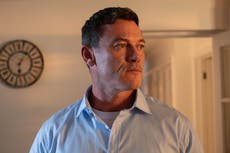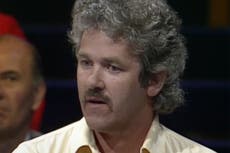John Cooper: The true story of the Pembrokeshire Murders serial killer exposed by an appearance on Bullseye
Everything you need to know about the real-life murderer inadvertently identified by an ITV game show
John Cooper, the serial killer dramatised in ITV’s The Pembrokeshire Murders, was described by a judge as having perpetrated “such evil wickedness” that only four whole life sentences would suffice. That verdict, handed down in 2011, capped three decades in which Cooper killed, assaulted and robbed with impunity.
Played by Keith Allen in the ITV drama, Cooper was a prolific burglar whose crimes escalated to violent murder in 1985. Yet he remained uncaptured until 1998, with his involvement in a series of killings and rapes only coming to light years later.
In court, Cooper’s son would recall his father roaming the sleepy town of Milford Haven in Pembrokeshire, Wales, with a shotgun concealed under his coat. Secretly, Cooper was looking for houses to break into, and used the skills learnt in his vast collection of SAS manuals to slip in and out undetected. Cooper is believed to have turned to crime after losing thousands of pounds attempting to break into the property market and gambling away the £90,000 he won in a 1978 newspaper competition.
In 1985, Cooper targeted a mansion in Milford Haven owned by millionaire farmer Richard Thomas and his sister Helen, who would become his first known murder victims. Prosecutors later speculated that Cooper had killed the siblings after being disturbed during the break-in, with the pair’s bodies, both bearing point-blank shotgun wounds, found in their burnt-out home days after the robbery.
The killings cast a dark shadow over Milford Haven, but police were unable to apprehend a suspect. It would be four years before Cooper struck again just as violently. Peter and Gwenda Dixon were a Oxfordshire couple holidaying on the Pembrokeshire coast when they encountered Cooper. Before killing the pair, again at point-blank range with a shotgun, Cooper tied them up close to a cliff edge and demanded their bank details. He would spend the rest of the day travelling from cashpoint to cashpoint, withdrawing money from the couple’s accounts. Police, meanwhile, were able to deduce that the same 12-bore shotgun was used in both the Thomas and Dixon murders. They had a serial killer on their hands.
Cooper, however, remained uncaptured. In 1996, he held a group of Milford Haven teenagers hostage during a robbery, raping one girl and sexually assaulting another. In 1997, he held a woman at gunpoint in her home in the small Pembrokeshire village of Sardis. Like many of his other female victims, the woman was bound and gagged, but managed to flee. It was this crime that eventually exposed him, with police arresting Cooper in 1998 in connection with a series of home invasions in the area.
During a raid on Cooper’s home, police recovered jewellery, silverware and photo frames, some still bearing the photos of his victims. A pair of shorts were also recovered. Cooper was sentenced to 16 years in prison on 30 counts of robbery and burglary, but it wasn’t until advancements in technology occurred that police were able to officially link him to the Thomas and Dixon murders, as well as the 1996 assaults.
Police would identify traces of Gwenda Dixon’s blood on the recovered shorts, believing Cooper kept them as a trophy. A sock that once belonged to Richard Thomas was also recovered from Cooper’s home, while traces of Peter Dixon’s blood were found beneath a fresh lick of paint on Cooper’s shotgun.
In an unusual twist, police also unearthed Cooper’s appearance on the darts-themed game show Bullseye in 1989. The episode was filmed and broadcast just a month before the Dixon killings, with Cooper boasting during the show that he was a geographical expert with extensive knowledge of the Pembrokeshire coastline upon which the Dixons were later killed. His appearance in the episode also matched a police sketch drawn in 1989, with a member of the public having noticed Cooper while he was accessing the Dixon’s money shortly after killing them.

Watch Apple TV+ free for 7 day
New subscribers only. £9.99/mo. after free trial. Plan auto-renews until cancelled.
ADVERTISEMENT. If you sign up to this service we will earn commission. This revenue helps to fund journalism across The Independent.

Watch Apple TV+ free for 7 day
New subscribers only. £9.99/mo. after free trial. Plan auto-renews until cancelled.
ADVERTISEMENT. If you sign up to this service we will earn commission. This revenue helps to fund journalism across The Independent.
Cooper was re-arrested just months after his sentence for robbery came to an end, though he protested his innocence throughout his new trial. In 2011, the prolific murderer, dubbed “The Pembrokeshire Killer” or even “The Bullseye Killer” by the press, was finally sentenced to life in prison. He claimed on the stand that the truth would “all come out on the internet”, yet his attempt at an appeal was rejected a year later.
Since his imprisonment, Cooper has been linked with at least five other possible deaths in the Pembrokeshire area. The investigations continue.
The Pembrokeshire Murders airs over three nights on ITV, starting 11 January at 9pm
Join our commenting forum
Join thought-provoking conversations, follow other Independent readers and see their replies
Comments

Bookmark popover
Removed from bookmarks